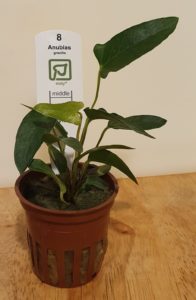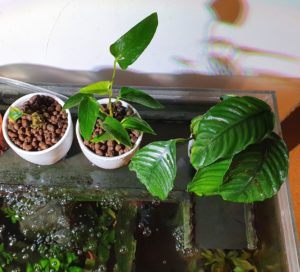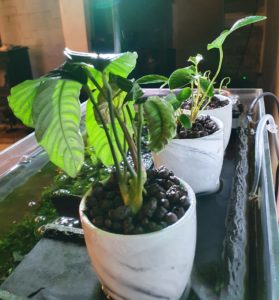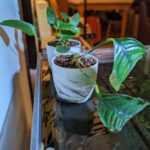After repeated struggles to grow emersed plants on the Shrimphaus river using a variety of substrate set-ups, I’ve switched over to actual LECA – lightweight expanded clay aggregate. For this experiment, I’m going with two reputedly robust to low(er) humidity emersed growth anubias: Anubias coffeefolia, and Anubias gracilis. This is the second attempt with Anubias coffeefolia, but the previous go seemed encouraging, with some new leaves forming before ultimately the plant was done in by rhizome rot.
Adapting plants to grow in LECA
Although aquarium plants are generally grown in emersed form in the nursery, they are typically potted in rockwool in a near 100% humidity hydroponic ebb and flow environment. Transitioning terrestrial plants to LECA can be challenging and there are a lot of helpful resources with great tips available including to make sure every last bit of non-LECA substrate has been removed from the roots before planting in LECA. The process seemed straightforward but the plants started wilting almost immediately. It’s pretty well established that misting plants directly doesn’t meaningfully raise humidity so I did an improvisation with the conical plastic sleaves the plants shipped in. Cutting off the bottom of the cone to fit snugly halfway up the pot gave a large surface area on top that could be misted to both keep a lot of water droplets around for a reasonable length of time close to the leaves and to provide a locally semi-isolated environment. I kept the plants in the enriched humidity setup for three weeks, misting a couple times a day. That seemed to mostly do the trick to give the plants enough time to adapt to being rooted in LECA; the gracilis didn’t really lose any leaves to wilting, and although the new coffeefolia did lose half its leaves it seems to have stabilised (hopefully).
Repotting to get rhizomes out of substrate
Five weeks after planting, it was time to take the plants out of the LECA to see how the roots were doing and repot if necessary. Pretty much things were looking good, with healthy looking whitish roots with good structure. There were however some brown rotted aspects in places, in particular where the rhizomes had been embedded in the substrate. I used pinsettes to trim off those portions and gave the root systems a good rinse. Then I replanted taking care to have the entirety of the rhizomes out of the LECA. This meant essentially having the plants growing on the side relative to how they arrived in rockwool. Possibly an ebb and flow hydroponics system in the nursery is more permissive since plants can dry out during the ebb phase, compared to the steady-state semi-hydroponics method of sitting LECA embedded plants in the Shrimphaus river. The repotting process was easy and the repotted plants look good so far, but the real test will be whether the rotting stops and we start to get some new growth.








